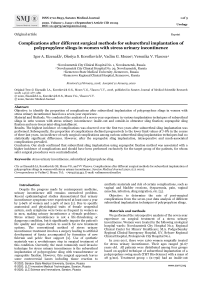Complications after different surgical methods for suburethral implantation of polypropylene slings in women with stress urinary incontinence
Автор: Igor A. Eizenakh, Olesiya S. Korotkevich, Vadim G. Mozes, Veronika V. Vlasova
Журнал: Saratov Medical Journal @sarmj
Статья в выпуске: 1 Vol.1, 2020 года.
Бесплатный доступ
Objective: to identify the proportion of complications after suburethral implantation of polypropylene slings in women with stress urinary incontinence based on a seven-year experience. Material and Methods. We conducted the analysis of а seven-year experience in various implantation techniques of suburethral slings in 1260 women with stress urinary incontinence: inside-out and outside-in obturator sling fixation; suprapubic sling fixation and non-trocar mini-sling installment. Results. The highest incidence of complications was observed over the first two years after suburethral sling implantation was performed. Subsequently, the proportion of complications declined progressively to the lower limit values of 7-8% in the course of three last years. An incidence of early surgical complications among various suburethral sling implantation techniques had no statistically significant differences. However, after the suprapubic sling implantation, intraoperative and mesh-associated complications prevailed. Conclusion. Our study confirmed that suburethral sling implantation using suprapubic fixation method was associated with a higher incidence of complications and should have been performed exclusively for the target group of the patients, for whom safer surgical procedures were contraindicated.
Stress urinary incontinence, suburethral polypropylene sling
Короткий адрес: https://sciup.org/149135009
IDR: 149135009 | DOI: 10.15275/sarmj.2020.0105
Список литературы Complications after different surgical methods for suburethral implantation of polypropylene slings in women with stress urinary incontinence
- Lucas MG, Bedretdinova D, Berghmans LC, et al. Guidelines on Urinary Incontinence. European Association of Urology 2015; 75 https://uroweb.org/guideline/urinary-incontinence/
- Maher C, Feiner B, Baessler K, et al. Surgical management of pelvic organ prolapse in women. Cochrane Database Syst Rev 2013; 4: CD004014. http://dx.doi.org/10.1002/14651858.CD012376
- Shaikh S, Ong EK, Glavind K, et al. Mechanical devices for urinary incontinence in women. Cochrane Database Syst Rev 2006; 3: CD001756. http://dx.doi.org/10.1002/14651858.CD001756.pub6
- Herbison GP, Arnold EP. Sacral neuromodulation with implanted devices for urinary storage and voiding dysfunction in adults. Cochrane Database Syst Rev 2009; 2: CD004202. http://dx.doi.org/10.1002/14651858.CD004202.pub2
- Haylen BT, Freeman RM, Swift SE, et al. An International Urogynecological Association (IUGA). International Continence Society (ICS) joint terminology and classification of the complications related directly to the insertion of prostheses (meshes, implants, tapes) and grafts in female pelvic floor surgery. Neurourol Urodyn 2011; 30(1): 2-12. http://dx.doi.org/10.1002/nau.22199
- Niemark AI, Razdorskaya MV, Neimark BA. Correction of stress urinary incontinence in women with a suburethral meshes. Kazan Medical Journal 2012; 93(3): 538-542. https://doi.org/10.17816/KMJ1889
- Eizenakh IA, Vlasova VV, Mozes VG, et al. Early postoperative mesh-related complications after placing two-and four-sleeved synthetic of implants women with genitals prolapse. Medicine in Kuzbass 2017; 1(16): 12-18. https://cyberleninka.ru/article/n/rannie-mesh-assotsiirovannye-posleoperatsionnye-oslozhneniya-pri-ustanovke-sinteticheskih-setchatyh-implantov-s-dvumya-i-chetyrmya
- Nygaard IE, Shaw JM. Physical activity and the pelvic floor. Am J Obstet Gynecol 2016; 214(2): 164-171. http://dx.doi.org/10.1016/j.ajog.2015.08.067
- Wein AJ. Tension-Free Vaginal Tape-Obturator for Treatment of Pure Urodynamic Stress Urinary Incontinence: Efficacy and Adverse Effects at 10-Year Follow-up. J Urol 2018; 199(2): 347-348.
- Rautenberg O, Zivanovic I, Kociszewski J, et al. Current Treatment Concepts for Stress Urinary Incontinence. Praxis (Bern 1994) 2017; 106(15): 1-8. http://dx.doi.org/10.1024/1661-8157/a002843


